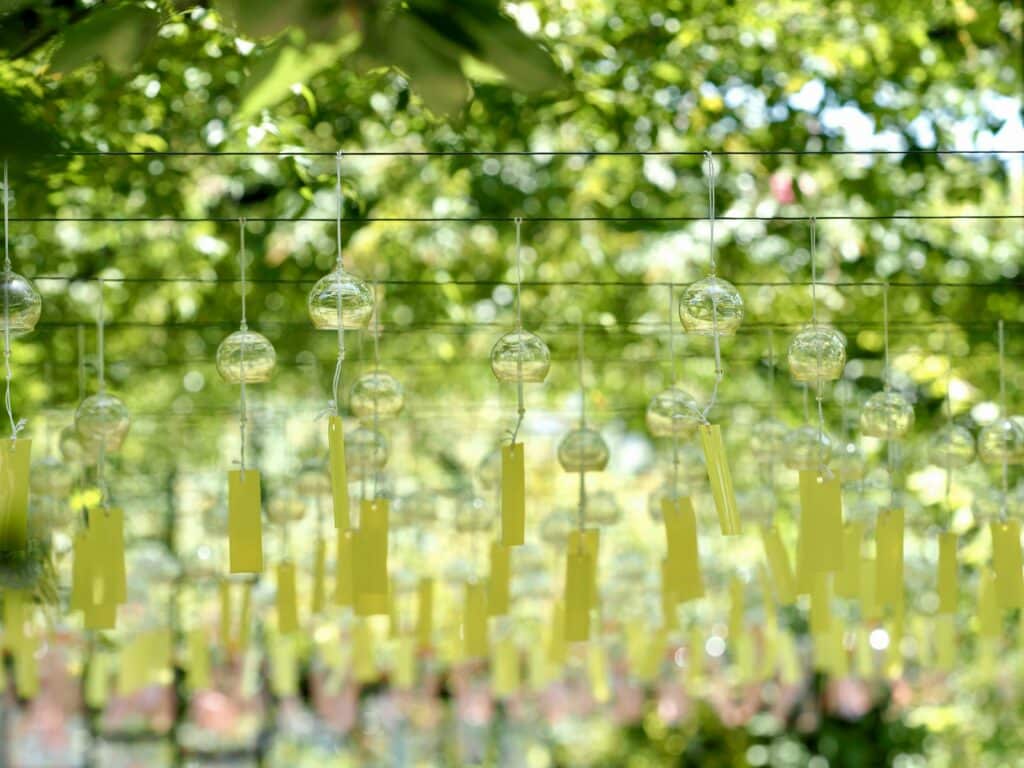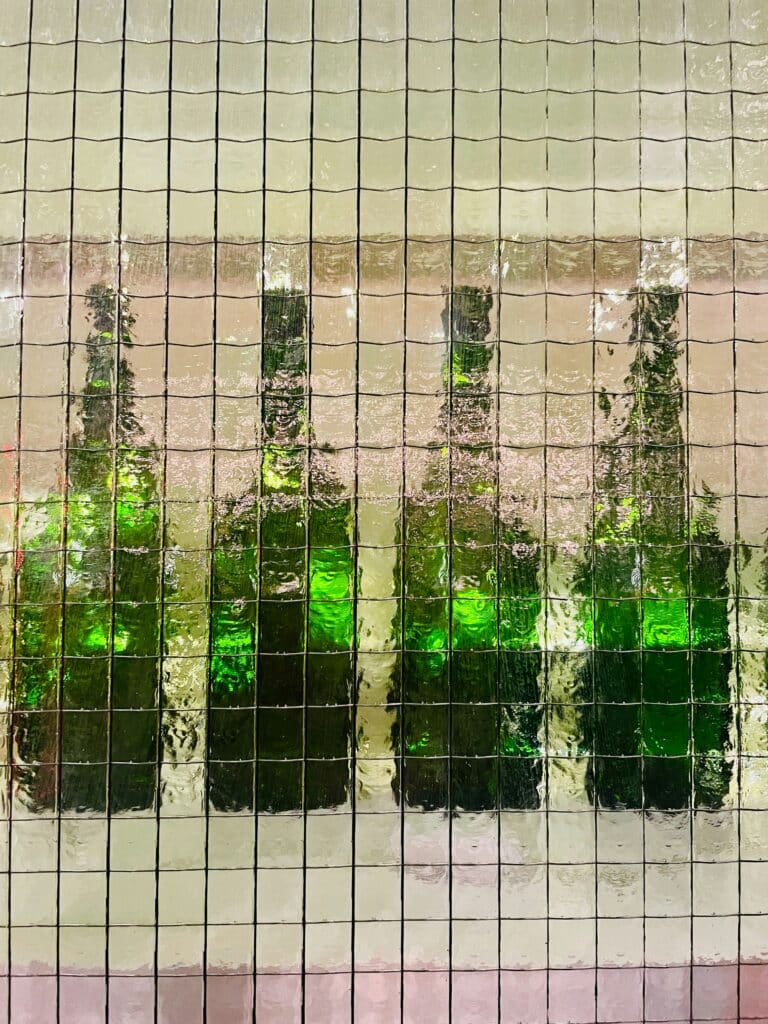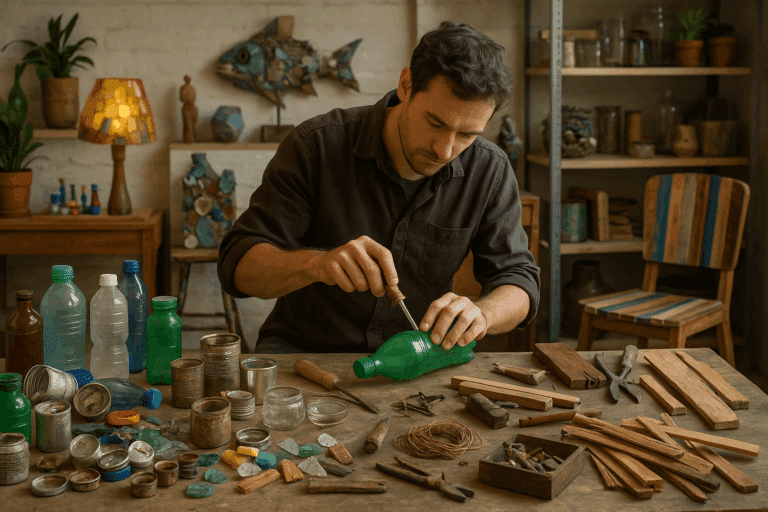Yet, with a hint of creativity, and a touch of patience, these objectives are not only attainable but can result in a captivating spectacle. Our focus in this discussion will be on the ingenious use of recycled glass bottles to edge your garden, an aesthetic yet functional practice that exudes eco-friendly elegance.
Recycled glass bottle edging is an innovative gardening technique that involves the utilization of old glass bottles, particularly their bottoms, to define your garden’s boundaries or individual sections within it. The charm lies not just in its eco-friendliness, but also in the kaleidoscope of colors that these glass bottles bring to your garden, making it an eye-catching spectacle.

In this guide, we’ll share essential tips and tricks on how to revamp your garden using recycled glass bottles. From choosing the right bottles, cutting them safely, preparing the edging site, to the actual installation process, every stage requires careful attention. Our mission is to provide comprehensive insights into the process, ensuring a stunning yet eco-friendly transformation of your garden.
Moreover, we will delve into the benefits of this unique gardening technique. Beyond the aesthetic appeal, recycled glass bottle edging has several advantages, including deterring unwanted pests, improving soil aeration, and contributing to waste reduction. Understanding these benefits will enhance your appreciation for this innovative gardening approach.
Prepare to be inspired by the magic of recycled glass bottle edging. It is an art that combines sustainability with elegance, an art that transforms mundane spaces into magnificent spectacles, and an art that allows you to contribute your bit to the environment. We invite you to join us on this captivating journey of garden transformation. So, let’s dive into the world of eco-friendly elegance!
Understanding Recycled Glass Bottle Edging
In the field of gardening, eco-friendly practices are continually gaining momentum as they promote sustainability while enhancing aesthetic appeal. A case in point is recycled glass bottle edging. This method involves the use of discarded glass bottles, which, rather than ending up in landfills, are given a second life as decorative borders for your garden. It’s a brilliant example of how creative reuse can merge practicality with beauty.
By embedding glass bottles—neck-down or sideways—into the soil, gardeners can define walkways, flower beds, or vegetable patches with vibrant, glimmering borders that reflect light and draw the eye. Each bottle acts as both a structural element and a design feature. Clear, green, brown, and even cobalt blue bottles create a dynamic color palette, offering an affordable and accessible way to personalize outdoor spaces.
Beyond aesthetics, this method also underscores a growing consciousness about environmental impact. Gardeners who adopt recycled bottle edging demonstrate that sustainability doesn’t require compromise—it can actually enhance the visual and functional qualities of a garden. The bottles are naturally weather-resistant, and when installed securely, they require minimal upkeep.
Moreover, the process of collecting, cleaning, and arranging the bottles can be an enjoyable and rewarding experience. It allows for hands-on creativity and provides a tangible connection to sustainable living. Whether sourced from your own recycling bin or gathered from friends, family, or local businesses, each bottle tells a story—making your garden not only a showcase of plants but also a narrative of renewal and care for the Earth.
Incorporating recycled glass bottle edging is more than a decorative choice; it’s a statement of values—blending craftsmanship, environmental stewardship, and artistic flair into a truly unique garden feature.
The primary benefits of recycled glass bottle edging are twofold: environmental conservation and unique elegance. Firstly, this approach helps reduce waste and promotes recycling – an essential aspect of sustainable living. Secondly, glass bottles, with their array of colors and shapes, offer a distinctive charm that’s hardly achievable with traditional garden edging materials like wood or stone.
Cutting and Safety Precautions
Once your bottles are clean and inspected, you may choose to cut them, depending on the design of your garden edging. While some designs incorporate whole bottles placed neck-down into the soil, others involve cutting bottles in half and using the bottom sections as uniform border pieces. If you decide to cut the bottles, ensure you’re using the correct tools—such as a glass cutter and warm-water separation method—and always wear safety gear including gloves and eye protection.
Smooth any sharp edges with sandpaper or a sanding stone to make the bottles safe to handle and to prevent injury after installation. You may also soak the edges in vinegar to help remove any lingering roughness.
Designing the Layout
Before digging, it’s helpful to lay out your bottles along the garden bed to get a sense of spacing, alignment, and aesthetic flow. You can experiment with different color sequences—like alternating greens, ambers, and blues—or go for a uniform look with identical bottles.
Installation
To install the bottles, dig a trench deep enough to bury about one-third to one-half of each bottle. This ensures stability, especially in high-traffic areas or places prone to strong winds. Pack the soil firmly around each bottle base to keep them secure.
This creative reuse project not only beautifies your space but also contributes to a more sustainable lifestyle.
Choosing the Right Glass Bottles
The first step in the process of creating recycled glass bottle edging involves selecting the appropriate bottles. You can source them from various places, including your own recycling bin, local recycling centers, or restaurants and bars that might otherwise dispose of them.

When choosing your bottles, consider factors like color, shape, and size. Different colored bottles can create a striking visual effect, while the size and shape of the bottle can affect the overall look and stability of your edging.
Preparing Your Bottles
Once you’ve sourced your bottles, the next stage involves preparing them for use. First, you’ll need to clean them thoroughly, both inside and out. This can be done using warm water and dish soap, followed by a rinse and air drying.
Next, remove any labels or adhesive residue. A razor blade or steel wool can be effective for this. Be sure to wear protective gloves during this process to avoid any potential injuries.
Finally, assess each bottle for cracks or chips. Damaged bottles can be hazardous and should not be used for edging.
Designing Your Edging Layout
Before you start digging, it’s vital to design your edging layout. You can do this by arranging your bottles on the ground along the desired border of your garden. This gives you an opportunity to experiment with different designs and color patterns until you find a look that you’re satisfied with.
Installing Your Recycled Glass Bottle Edging
With your design in place, the next step is installation. Start by digging a trench along your border. The depth of the trench should be such that when a bottle is placed in it upside down, its base is level with or slightly above the ground surface.
Then, place your bottles in the trench upside down, one after another. This upside-down positioning not only gives a unique look but also provides stability. The neck of the bottle, being narrower, goes into the soil, while the wider base remains above the ground.
Once your bottles are positioned, backfill the trench with soil, packing it tightly around each bottle. This helps to secure the bottles firmly in place.
Maintaining Your Edging
In terms of maintenance, recycled glass bottle edging is relatively hassle-free, making it a great long-term solution for defining garden borders. Unlike wood, which may rot or warp over time due to moisture and pests, glass maintains its shape and appearance with minimal effort. Additionally, colored glass retains its vibrancy far longer than painted or stained materials, resisting the fading effects of sun and rain exposure.
However, like any outdoor element, some care is necessary to keep your edging looking its best. Over time, dirt, debris, and mineral deposits from rainwater can build up on the surface of the bottles. A simple cleaning routine—using a soft cloth, warm water, and mild dish soap—can restore the bottles’ sparkle and prevent clouding. For hard-to-reach crevices or stubborn grime, an old toothbrush works wonders.
It’s also wise to periodically check the stability of the bottles. Garden soil can shift over time due to weather changes, watering, or natural settling. Make sure each bottle remains firmly planted in the ground to maintain a tidy, secure border. If you notice any bottles leaning or becoming loose, simply reset them by removing a bit of surrounding soil, pressing them back in, and tamping down the earth around them.
Further Enhancements
To elevate the appearance of your recycled glass bottle edging, think beyond just placement. Incorporating lighting can dramatically transform the look of your garden border, especially at dusk or nighttime. Solar-powered LED path lights are an excellent choice, offering an energy-efficient and low-maintenance option for illumination. Placing these lights to shine across or directly into the bottles can create a stunning visual effect, with the glass catching and diffusing the light to form glowing highlights.
For those looking to add a creative twist, consider backlighting the bottles with LED strip lights or small solar fairy lights. Tucking these lights behind the row of bottles can give your garden a whimsical, magical glow—perfect for evening gatherings or simply enjoying your outdoor space after sunset.
Additional Tips and Tricks
If you’re aiming for a more cohesive appearance, try organizing the bottles by size, shape, or color. Uniformity in bottle height can create a polished, intentional look, while mixing different colors can result in a more playful, eclectic edge. For a stained-glass effect, painting the insides of clear bottles with translucent glass paint can introduce new color variations and a unique artisan flair.
Safety is another key consideration. Always inspect bottles for sharp edges or cracks before installation. If you’re working with bottles that have been cut, it’s vital to sand the edges thoroughly or embed them deeper into the ground so only the smooth neck is visible. This minimizes the risk of injury while still preserving the design.
You can even repurpose different types of bottles for different zones of your garden—wine bottles for ornamental flower beds, soda bottles for herb gardens, or unique vintage bottles for focal points. This approach adds character and showcases your personality throughout the space.
In a nutshell, recycled glass bottle edging is an innovative, sustainable, and visually striking way to enhance your garden. It’s a project that harmonizes creativity, practicality, and environmental consciousness. With regular care, clever enhancements, and a dash of imagination, your bottle-edged garden can become a stunning example of what eco-friendly design can achieve. Happy gardening! 🌿🥂🌼project, patience and creativity are key to achieving the best results. Happy gardening!
Conclusion
Recycled glass bottle edging is more than just a creative gardening trend—it’s a meaningful step toward sustainable living and conscious design. By repurposing materials that might otherwise end up in a landfill, this approach not only minimizes waste but also adds a touch of individuality and charm to any outdoor space. The reflective qualities and diverse colors of glass bottles create dynamic borders that shift with the light, making your garden both a sanctuary and a statement piece.
One of the greatest strengths of glass bottle edging lies in its durability. Unlike wood or plastic alternatives, glass doesn’t rot, fade, or degrade quickly over time. With minimal upkeep—an occasional rinse and regular inspection for safety—this kind of edging can last for many seasons, retaining its beauty and function year-round.
The versatility of design options also cannot be overstated. Whether you opt for a uniform row of matching bottles or a whimsical collage of different shapes and shades, your edging becomes an extension of your personality. You can even elevate the aesthetic with solar lighting or artistic painting, adding ambiance and visibility to your garden at night.
Ultimately, installing recycled glass bottle edging is not only an eco-conscious choice but also a deeply rewarding one. It invites creativity, supports sustainability, and brings a unique artistic flair to the natural world just outside your door. With a little planning and care, you can transform discarded bottles into a glowing border that frames your garden with beauty and purpose.
So why not take the next step? Start collecting bottles, spark your imagination, and let your garden tell a greener, brighter story—one bottle at a time. 🌿💡🌎



